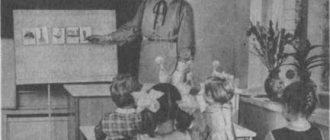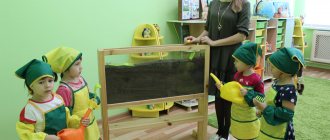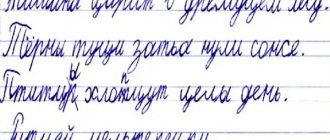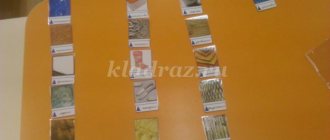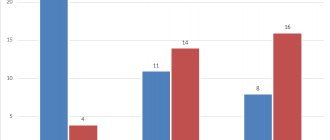Development of language analysis and synthesis among primary school students
Development of language analysis and synthesis skills
among elementary school students.
One of the main directions of speech therapy work to eliminate errors in writing is the development of language analysis and synthesis.
Language analysis and synthesis involves:
1. Analysis of sentences into words and synthesis of words in a sentence;
2. Syllable analysis and synthesis;
3. Phonemic analysis and synthesis.
Let's look at each position in more detail.
Sentence structure analysis
Analysis of sentence structure involves the ability to determine the number, sequence and place of words in a sentence.
In order to form and develop this skill, Babushkina L.A. offers students the following tasks:
1. determine the boundaries of the sentence in the text;
2. come up with a sentence based on the plot picture and determine the number of words in it;
3. come up with a sentence with a certain number of words;
4. increase the number of words in a sentence;
5. make sentences from words given in disorder or deformed sentences;
6. make sentences based on several pictures that depict the same object in different situations. Children come up with sentences based on the pictures. Then they name a sentence in which the word is first in the sentence, then a sentence in which this word is in second place, then in third place;
7. come up with a sentence with a certain word;
8. draw up a graphic diagram of a sentence: a sentence is indicated by a whole stripe, words – by small stripes;
9. come up with a proposal using a graphical diagram;
10. determine the place of a word in a sentence (counting);
11. raise the number corresponding to the number of words in the sentence.
Syllable analysis and synthesis
Syllabic analysis and synthesis involves the ability to divide a word into its constituent syllables. This is of great importance for mastering writing skills. In addition, syllable analysis helps our students more effectively master the sound analysis of words.
The word is divided into syllables, then the syllable, which is a simpler speech unit, is divided into sounds.
A typical mistake is the omission of vowels, which, when relying on internal or whispered pronunciation, are perceived as shades of consonant sounds, which are kinesthetically clearer.
Division into syllables helps highlight vowels. In syllabic analysis, the emphasis is on vowel sounds.
In the process of forming syllabic analysis and synthesis, it is important to take into account the stage-by-stage formation of mental actions
. First, the work is carried out relying on auxiliary means and materialized actions. Subsequently, syllable analysis and synthesis are carried out in terms of loud speech. At subsequent stages of work, this action is transferred to the internal plane, its implementation on the basis of auditory and pronunciation ideas.
When forming the action of syllabic analysis based on external auxiliary means, students are offered the following tasks: clap or tap the word syllable by syllable, accompany the syllable-by-syllable pronunciation of the word with a hand movement from right to left or left to right. Students are asked to perceive the movements of the lower jaw with the back of their hand. This technique is good to use because vowel sounds are pronounced with a greater opening of the oral cavity, with a greater lowering of the lower jaw than consonant sounds. The number of movements of the lower jaw corresponds to the number of vowel sounds and syllables in a word.
In the process of developing syllabic analysis in speech terms, the main task is the ability to isolate vowel sounds in a word
. At this stage, children must learn the basic rule of syllabic division: there are as many syllables in a word as there are vowel sounds. Relying on vowel sounds eliminates writing errors such as missing or adding vowels.
In order to more effectively develop the ability to determine the syllabic composition of a word based on vowels, preliminary work is necessary to develop the differentiation of vowels and consonants, and to isolate vowel sounds from a word. This work begins in primary school and continues until the child is removed from speech therapy.
In work on isolating a vowel sound from a syllable, syllables of different structures with different vowels are proposed, for example: ah, us, ma, yes, kra, ast, zol
.
The following tasks are used:
- name only the vowel sound of the syllable;
- raise the letter corresponding to the vowel sound of the syllable;
- write down only the vowels of the syllables;
- come up with a syllable with the corresponding vowel;
- determine the place of the vowel sound in a syllable and show the corresponding letter;
- come up with a syllable in which the vowel sound is in first, second or third place.
Next comes work on isolating vowel sounds from a word. First, monosyllabic words of various structures are offered (um, yes, catfish, wolf, yard). Children determine what vowel sound is in a word and its place (beginning, middle, end). A corresponding graphic diagram of words is drawn up. Next comes similar work on the material of two- and three-syllable words.
The following exercises are recommended:
- name the vowel sounds of the word;
- write down only the vowels of a given word on the diagram;
- select vowel sounds from a word, put the corresponding letters of the split alphabet;
- arrange the pictures under vowel letters, first the children name these pictures;
- arrange the pictures under various graphic diagrams on which only vowel letters are written;
- come up with words using various graphic patterns on which vowel letters are written.
Consolidating the actions of syllable analysis and synthesis
are carried out using the following tasks:
- repeat the given word syllable by syllable, count the number of syllables;
- determine the number of syllables in the named words, raise the corresponding number;
- arrange the pictures in two rows depending on the number of syllables in their names;
- name flowers, trees, domestic and wild animals, dishes or furniture whose names have two or three syllables;
- Select the first syllable from the names of the pictures and write it down. Combine the syllables into a word or sentence and read. For example, I give children pictures: car, baby, cube, dad, paw, palm, shirt. After highlighting the first syllable in the words, the sentence “Mom bathed Lara” is obtained;
- identify the missing syllable in the title of the picture;
- form a word from syllables given in disorder;
- identify a word or sentence pronounced syllable by syllable;
- select words consisting of 1, 2, 3 syllables from sentences;
- Based on the plot picture, name words of 1, 2, 3 syllables. First, children name the objects shown in the picture;
- didactic games “Train”, “Playing School”, “Syllabic Confusion”, etc.
At the last stage of the work, tasks are offered to form the action of syllabic analysis and synthesis in the mental plane
, based on auditory-pronunciation representations:
- come up with words with one, two, three syllables;
- come up with a word with a certain syllable at the beginning of the word, for example with the syllable ma;
- come up with a word with a certain syllable at the end of the word, for example with the syllable ka;
- determine the number of syllables in the names of the pictures (without first pronouncing them);
- raise the number (1, 2, 3) in accordance with the number of syllables in the name of the picture. The speech therapist shows a picture without naming it;
- Based on the plot picture (without first naming the objects), name a word of one, two, three syllables.
Exercises using letters of the split alphabet, writing syllables are also useful
:
- make syllables from letters of the split alphabet;
- change the order of sounds in a word, name the resulting syllable. The speech therapist reads the syllable, the children reproduce the sounds of the syllable in reverse order;
- working with tables of syllables. The speech therapist shows the letters in a certain order and gives the task to name the syllable;
- make pairs of syllables from the letters of the alphabet, consisting of the same sounds: mo - om, sha - ash;
- write down only syllables beginning with a vowel sound;
- write down only syllables that end with a vowel sound;
- record open and closed syllables from dictation.
These exercises are quite difficult for students, but very effective in terms of developing syllabic analysis and synthesis.
Phonemic analysis and synthesis
Phonemic analysis can be basic or complex. Elementary phonemic analysis is the separation of sounds from the background of a word. A more complex form is to isolate the first and last sound from a word, determining its place (beginning, middle, end). And finally, the most complex form of phonemic analysis is determining the sequence of sounds in a word, their quantity, and place in relation to other sounds. Our children master such phonemic analysis with difficulty, due to the rigidity of mental processes (V.K. Orfinskaya).
Practice shows that errors caused by unformed language analysis and synthesis are the most common and difficult to correct. Therefore, systematic and consistent work with children to overcome them acquires special significance in the correction of dysgraphia.
The work on developing language analysis and synthesis includes 3 stages: developing skills in language analysis and synthesis; development of syllabic analysis and synthesis; development of sound-letter analysis and synthesis. Conventionally, we can distinguish 3 levels of correction: syntactic, lexical and phonetic.
Objectives of exercises to form and develop skills in analysis and synthesis of sentence structure:
1. To develop the ability to determine the intonation completeness of a sentence. This skill helps children develop the concept of a sentence as a single syntactic unit. Its development in the classroom can take place in the form of a game, in the form of oral work, using written exercises: placing periods correctly, putting the necessary punctuation mark at the end of a sentence, etc.
2. Develop the ability to determine the number, sequence and place of words in a sentence. Solving this problem requires relying on visual material (subject and plot pictures, diagrams, cards): come up with a sentence based on the plot picture and determine the number of words in it; come up with a sentence with a certain number of words; expand the sentence by increasing the number of words; make sentences based on several pictures that depict the same object in different situations. For example, children come up with sentences with the word “oak”: “An oak tree grows near the school. Leaves appeared on the oak tree. Birds have built nests on a tall oak tree. Children play under the oak tree.” Then students name a sentence in which the word “oak” comes first, then a sentence in which this word comes second, etc. I offer children other tasks: come up with a sentence with a certain word; draw up a graphic diagram of a sentence (a sentence is indicated by one long strip, words by short stripes); come up with a proposal using a graphical diagram; determine the place of a word in a sentence (which one); raise a card with a number corresponding to the number of words in the sentence (cards can be replaced with a fan with numbers).
3. Teach children to compose sentences from words given out of sequence (without changes and with changes in the grammatical forms of words). To solve this problem, preparatory exercises aimed at developing new skills are necessary. The degree of children's participation in them is reduced to a minimum, since the main thing is to master the algorithm for their implementation.
I first carry out correction work on the material of words given in the required grammatical form. For students who experience particular difficulties in determining the order of words in a sentence, I suggest working on cards where one word in a row is written with a capital letter. At subsequent stages I complicate the task.
To develop auditory attention and the ability to correctly grammatically formulate sentences in oral speech, I suggest correcting inconsistencies in sentences (“Truth or a joke?”, “Correct mistakes”). Such tasks arouse interest and introduce an element of competition into classes. All students strive to show ingenuity and intelligence. Moments of emotional release should be present in every correctional lesson. It would be great if they became an integral part of it.
When working with prepositions, I first clarify the spatial meanings of prepositions based on diagrams, and then their other meanings. To reinforce the ability to choose the right preposition, I use didactic games, for example, “Choose a word, name a preposition” (ball game). Equipment: magnetic board, subject pictures, preposition diagrams, ball. On the board there are object pictures: a child, a pipe, a ball, checkers, cubes, a puppy. I say the word “plays” and throw the ball to one of the children. The student names the phrase adding the required preposition: “Plays the pipe.” The ball is then passed to the next player. The children who make no mistakes in their answers win.
Another version of the game. On the board there are subject pictures: squirrel, sofa, flower, basket, plane, car. Below the pictures are diagrams of prepositions. I say the word “flies” and throw the ball to one of the children. The student makes up the sentence “the plane is flying over the city” and returns the ball to the teacher. The presenter calls the new word “growing” and throws the ball to the next player. The children who make no mistakes in their answers win.
Didactic game “Sharpshooters”. Equipment: preposition cards, targets (cardboard squares), round magnets, blue and red chips. Students have two cards (the number of cards can vary depending on the number of players) with prepositions written on them (in, on, under, for, with, from, etc.). On the board are sentences with targets instead of prepositions. The players read the sentences in a whisper. Then the student(s), who believes that he has the card with the required preposition, goes to the board. A preposition card is placed in place of the target. The student reads the sentence. If the target is hit, he receives a blue chip; if he is wrong, he receives a red chip. The students with the fewest red chips win.
At the same time, I include tasks to develop the ability to write prepositions and words separately. To better remember the rules, I read N. Betenkova’s quatrain:
From the forest, to the meadow, to the clearing,
By a bush, from a path, into a hole,
From the river, near the road -
Write all the prepositions separately!
Then I work on differentiating prepositions and prefixes. At this stage of correction, training exercises are significant, which help overcome errors in language analysis and synthesis and allow children to automate the process of distinguishing them.
Objectives of exercises on the formation of syllabic analysis and synthesis at the lexical level:
1. To develop the ability to determine the number, sequence and place of syllables in a word. Work in this direction begins with updating existing knowledge about words and syllables in the classroom. A differentiation is made between the concepts “word” and “syllable”. Then children complete tasks aimed at strengthening the ability to distinguish between these concepts. The tasks, as a rule, are of a playful nature: “Clap your hands if you hear a syllable,” “Wave your hands above your head if it’s a word,” “If I say a word, then smile, if it’s a syllable, frown.”
When determining the number of syllables based on external auxiliary means, I use the following techniques: clap or tap the word syllable by syllable; accompany the syllable-by-syllable pronunciation of a word with a hand movement from right to left or left to right.
To develop the ability to determine the sequence of syllables in a word, I offer the didactic game “Name a Word,” which helps to consolidate vocabulary words. Equipment: magnetic board, subject pictures, chips. The game can be played in two stages.
First stage. On the board there are pictures: apple, kitten, banana, book, cucumber, dog, crow, potato, bus. I name the vowels that are in the title of one of the pictures. Students must name the intended word and pronounce it orthographically, syllable by syllable. Then the children write the word in a notebook and underline the vowels. The correct answer is rewarded with a chip. Those with more chips win.
Second stage (work at the level of phrases). Children match the written nouns with suitable adjectives with the same number of syllables: tasty apple, juicy apple; ripe banana, yellow banana, etc. Those with more chips win.
2. Teach syllabic analysis and synthesis of words. Work on isolating a vowel sound and a syllable from a word involves the use of the following tasks: name the vowel sound of the word; raise the letter corresponding to the vowel sound; write down only the letters of vowel sounds; come up with a syllable with the corresponding vowel; determine the place of the vowel sound in the word, show the corresponding number; come up with a syllable in which the vowel is in first, second and third place.
At this stage of the work, word schemes are compiled: using only vowel sounds, distributing pictures depending on the number of syllables in their name, identifying the missing syllable in the name of the picture, isolating a word from a sentence consisting of a certain number of syllables. I offer exercises that carry an additional load, for example, “Make friends with words.” In it, it is necessary to divide the words of each series into two equal groups and explain the principle of grouping, and then write down words consisting of three syllables.
Cow, calf, lamb, sheep.
September, June, summer, autumn.
September, January, November, December.
Oak, pine, spruce, birch.
It should be noted that the implementation of such tasks is always lively and brings variety to the correctional work.
The task of tasks to form the action of syllabic analysis and synthesis is the development of phonemic processes, attention and memory. The multifunctional nature of some exercises contributes to the solution of this problem.
Phonetic work includes the development of sound analysis and synthesis of words of simple and complex forms, the formation of differentiation of phonemes that have similar characteristics.
Objectives of exercises on the formation of sound-letter analysis and synthesis:
1. To develop the ability to determine the number, sequence and place of sounds in a word.
2. To teach the ability to perform sound-letter analysis and synthesis of words (simple and complex forms). I begin work on developing the skills of sound-letter analysis and synthesis by consolidating the skills of the elementary form of sound analysis. If students with dysgraphia speak it well enough, they move on to developing complex forms of language analysis and synthesis. I carry out correctional work on the development of complex forms of language analysis and synthesis, taking into account the sequence of stages in the formation of mental actions.
In subgroup correctional classes with students in grades 3-4 on the development and consolidation of phonemic analysis and synthesis skills when differentiating paired voiced and voiceless consonants, I use sound strips rather than individual cards with known symbols of consonant sounds. They allow you to replace the traditional picking up of cards with symbols depicted on them by simply touching the selected symbol with a pencil or pen. For example, when distinguishing paired consonants b - p in words that are answers to riddles, before writing the word in a notebook, students show on the audio track what sound they heard in the word “squirrel”. Then I clarify which vowel indicates its softness, and then I write down the word. This allows you to avoid mistakes associated with replacing consonants and indicating their softness in writing with vowels. Such strips are convenient to use when conducting the didactic game “Unusual Traffic Light”, where they act as a traffic light. Equipment: sound tracks with images of symbols of consonant sounds, subject pictures (their selection is carried out taking into account a pair of differentiated voiced and voiceless consonants), a red card for the presenter. I ask students to help the words cross the road using a fancy traffic light, and then I show the pictures. Players determine which of the differentiated consonants will be in this word and touch the desired traffic light signal with a pointer. If a child makes a mistake, the presenter shows him a red card. After the error is corrected, the game continues. Children play with pleasure, practicing the ability to differentiate paired voiced and voiceless consonants.
At the final stage I use the didactic game “Clever Men and Clever Girls” (2-3 pairs of children play). Equipment: cards with written letters and numbers. The game is played in pairs. I propose to decipher the words and write them down, to combine the words into pairs according to some criterion: by the number of vowels in the words; by the same number of syllables, sounds, letters, vowels; by the presence of a certain spelling; within the meaning of. One word can be combined with several words (depending on the choice of basis for combining). For example: rainbow - colors (in meaning); cloud - dacha (according to the general spelling); tomato - rainbow (by number of syllables); paints - crumbs (according to the number of letters), etc. The team that managed to make the largest number of pairs of deciphered words in a certain time and explain the reasons for combining them wins.
3. Develop successive functions. I systematically conduct exercises aimed at developing successive functions that develop the ability to concentrate, distribute and switch attention. Work in this direction is not carried out in isolation, but in parallel with the development of various forms of language analysis and synthesis.
The use of effective exercises of a multifunctional nature helps to overcome specific writing errors in students and makes it possible to provide certain conditions for improving the quality of the correction process.
Tatiana PASTARNAKEVICH, teacher-defectologist at the Lyakhovichi gymnasium.
www.Logopedy.ru
Labo Rodika Stepanovna Speech therapist of the highest category, Tver
The formation of the phonetic and phonemic aspects of speech in children is a complex process. Mastering the basics of reading and counting even before the first bell rings, preventing errors in writing and reading, and the appearance of dysgraphic errors in learning to read and write is possible only in the process of intensive development of phonemic perception.
A modern school requires from children entering first grade not so much knowledge and skills as the ability to analyze and generalize. The main goal is the formation of the phonetic-phonemic aspect of a preschooler’s speech through the skill of sound-letter analysis of words.
Children's acquaintance with the sound side of a word begins in younger groups, when they are taught to clearly and distinctly pronounce vowels and consonants, individual words, and relate a word to an object. In middle-aged children, interest in the sound of words increases even more. They listen to the words, find similarities and differences, note intonation and expressiveness of speech. Older children distinguish sounds by ear, name words with a certain sound, find words with a given sound, and determine the place of the sound in a word. In the pre-school group, children are taught to divide two-syllable (pa-pa) and three-syllable (ma-li-na) words into syllables, find and name each part of the word.
The success of a child’s learning to read and write is largely determined by how well he or she masters the sound side of speech, since letters represent nothing more than the sounds of speech. Therefore, in order to learn letters, it is necessary:
- Be very clear about sounds
- Be able to pronounce them correctly
- Unmistakably distinguish them by ear,
- Determine the presence or absence of sound,
- The location of a given sound in a word.
However, when examining preschool children, specialists identify children who, with relatively intact hearing and correct lexical and grammatical structure of speech, have pronounced phonemic underdevelopment, but since parents and educators are not bothered by this defect, the children are left without timely speech therapy assistance. It turns out that children going to school are left with problems in the development of language analysis and synthesis, which will lead to persistent errors in mastering written language. If not corrected in time in childhood, they cause difficulties in communication and lead to personality changes in the “child-adolescent-adult” development chain, that is, they lead to the development of complexes in children.
Parents should take on the main burden of teaching their child to speak correctly. Solving speech therapy problems will require desire, faith and patience from parents, and of course the relationship between parents and teachers plays a big role in this. The special role of parents is necessary in the complex of the following activities:
- Compliance with uniform requirements for the child
- Monitoring the completion of tasks at home
- Get used to sound analysis
- Constantly activate the child’s auditory perception
- Do not move on to the next lessons until you have mastered the material from the previous ones.
References:
1. Z.E. Agranovich “To help speech therapists and parents” - St. Petersburg - Childhood-press. 2009
2. L.M. Kozyreva “A set of games and exercises for children 5-7 years old” - Moscow “Gnome and D” - 2006.
3. N.G. Altukhova “Learn to hear sounds” - St. Petersburg: Lan 1999.
4. L.P. Barylkina, I.P. Matraeva, L.P. Obukhova “These difficult consonants” - M.: 5 for knowledge, 2005.
5. A. Undzenkova, L. Koltygina “Zvukarik” - Ekaterinburg: ARD LTD, 1998.
6. E.A. Pozhilenko “The Magic World of Sounds and Words” - M.: Humanit. Ed. VLADOS, 2001
7. .3.A.Repina, V.I.Buiko “Lessons in Speech Therapy” - Ekaterinburg: Publishing House “Litur”, 2001.
8. S.A. Mironova “Development of speech of preschoolers in speech therapy classes” - M.: “Prosveshchenie”, 1991.
9. Zh.M. Flerova “Speech Therapy” - Rostov n/D: Phoenix, 2000.
10. M.F. Fomicheva “Education of correct pronunciation in children” - M.: “Education”, 1989.
11. V. Tsyntarny “We play, listen, imitate - we get sounds” - St. Petersburg: “Lan”, 1998.
12. O.I. Krupenchuk “Teach me to speak correctly” - St. Petersburg: “Litera”, 2003.
13. N.S. Varentsova, E.V. Kolesnikova “Development of phonemic hearing in preschoolers. - M. “Akalis”, 1995
| If you liked this article, share the link to the article with your friends and acquaintances on social media. networks using this button | If you have your own special opinion about the material presented, leave your comment in the form below |
Social commentary Cackle
